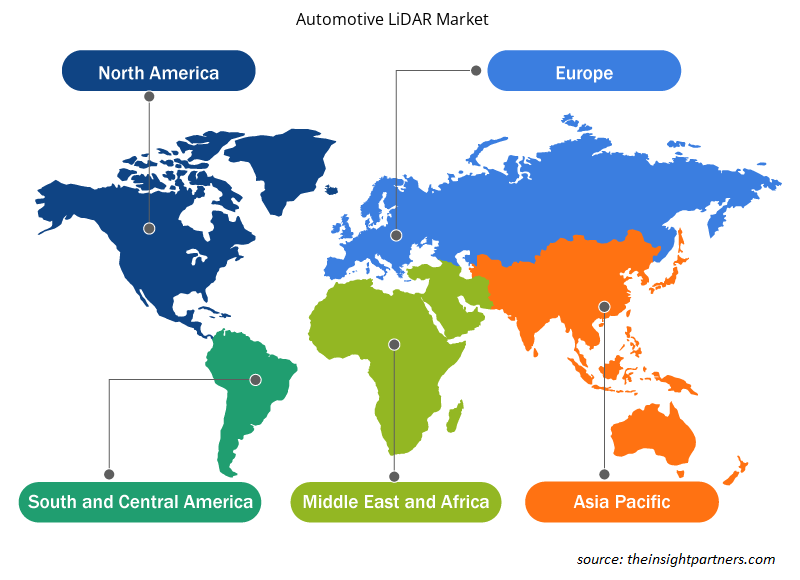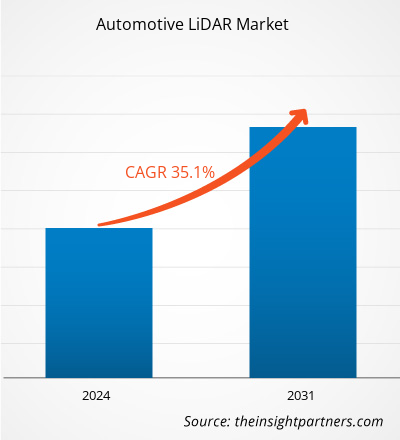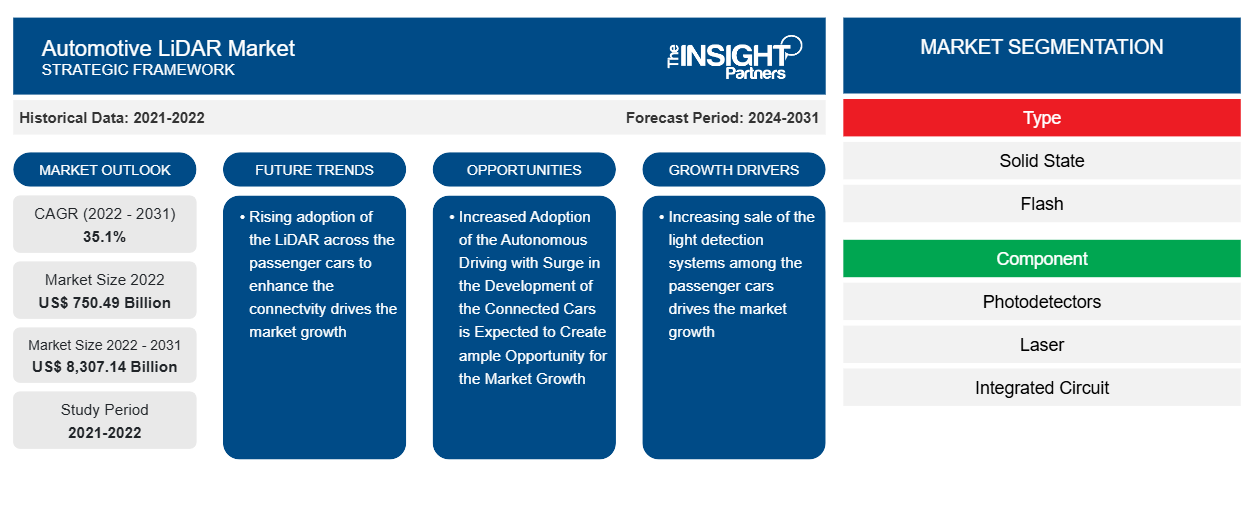Der Markt für LiDAR-Systeme für Kraftfahrzeuge soll von 750,49 Milliarden US-Dollar im Jahr 2022 auf 8.307,14 Milliarden US-Dollar im Jahr 2031 anwachsen. Der Markt soll in den Jahren 2022–2031 eine durchschnittliche jährliche Wachstumsrate (CAGR) von 35,1 % verzeichnen. Der Markt für LiDAR-Systeme für Kraftfahrzeuge wird durch die schnelle Einführung autonom fahrender Autos sowie einen Anstieg der Verkäufe vernetzter Autos angetrieben. Der Markt für autonomes Fahren soll bis 2035 einen Umsatz zwischen 300 und 400 Milliarden US-Dollar erzielen. Die gestiegene Nachfrage nach autonomen Personenkraftwagen in Industrieländern, darunter den USA und Kanada, treibt das Wachstum des Marktes für LiDAR-Systeme für Kraftfahrzeuge voran. Auch die weltweit gestiegene Nachfrage nach Luxusautos ist ein wichtiger Antriebsfaktor für das Wachstum des Marktes für LiDAR-Systeme für Kraftfahrzeuge im Prognosezeitraum.
Automotive LiDAR-Marktanalyse
Der Automobil-LiDAR-Markt wird durch steigende Verkäufe von Luxusfahrzeugen angetrieben, und die zunehmende Einführung von ADAS-Technologie in den Fahrzeugen treibt das Wachstum des Automobil-LiDAR-Marktes im Prognosezeitraum voran. Die zunehmende Entwicklung autonomer Fahrzeuge sowie ein Anstieg der Verkäufe von Elektrofahrzeugen mit LiDAR-Technologie dürften erhebliche Chancen für das Wachstum des Automobil-LiDAR-Marktes schaffen. Unternehmen auf dem Automobil-LiDAR-Markt konzentrieren sich auf die Entwicklung neuer Produkte und die Einführung neuer Sensoren auf Basis autonomer Technologien. So brachte Innoviz Technologies Ltd. im Januar 2022 den Innoviz360-Sensor der nächsten Generation in seine Produktlinie auf den Markt. Innoviz360 erzielte im Jahr 2023 Umsätze.
Marktübersicht für Automotive-LiDAR
Die zunehmende Verbreitung autonomer Fahrzeuge dürfte das Wachstum des Automobil-LiDAR-Marktes unterstützen. Automobil- und vernetzte Fahrzeugtechnologien nutzen LiDAR, um ihre Nutzung zu optimieren. Führende OEMs wie Audi AG, BMW AG, Ford Motors, Mercedes-Benz, Nissan Corporation, Tesla Inc. und AB Volvo bieten weltweit autonome Fahrerassistenz der Stufe 2 an. Dazu gehören Automobilsysteme, die beim Fahren auf Autobahnen Beschleunigungs-, Lenk- und Bremsunterstützung bieten. Die Verbreitung vernetzter Autos mit der zunehmenden Verbreitung automatisierter Fahrzeuge in der realen Welt in den Industrienationen, darunter Großbritannien, die USA und Deutschland, treibt das Wachstum des Automobil-LiDAR-Marktes im Prognosezeitraum voran. Vernetzte In-Car-Dienste bieten verschiedene Dienste wie vernetzte Karten, GPS-Systeme und app-basierte Musikstreaming-Unterstützung. All diese Faktoren werden voraussichtlich im Prognosezeitraum reichlich Möglichkeiten für das Wachstum des Automobil-LiDAR-Marktes schaffen.
Passen Sie diesen Bericht Ihren Anforderungen an
Sie erhalten kostenlose Anpassungen an jedem Bericht, einschließlich Teilen dieses Berichts oder einer Analyse auf Länderebene, eines Excel-Datenpakets sowie tolle Angebote und Rabatte für Start-ups und Universitäten.
-
Holen Sie sich die wichtigsten Markttrends aus diesem Bericht.Dieses KOSTENLOSE Beispiel umfasst eine Datenanalyse von Markttrends bis hin zu Schätzungen und Prognosen.
Treiber und Chancen auf dem Automotive-LiDAR-Markt
Der steigende Absatz von Lichterkennungssystemen bei Personenkraftwagen dürfte der Haupttreiber für den Automotive-LiDAR-Markt sein
Die zunehmende Verbreitung von Lichterkennungssystemen und die rasante Verbreitung moderner LiDAR-Lösungen in Personenkraftwagen sind im Prognosezeitraum die wichtigsten Wachstumsfaktoren für den Automobil-LiDAR-Markt. Darüber hinaus sorgen die rasch steigende Nachfrage nach autonomen und vernetzten Fahrzeugen sowie die zunehmende Zahl von Partnerschaften zwischen Automobilherstellern und anderen Organisationen für ein signifikantes Wachstum des Automobil-LiDAR-Marktes. Das autonome Auto bietet den Passagieren Komfort und verbessert die Sicherheit der Reisenden. Diese autonomen Fahrzeuge bieten mehreren Automobilunternehmen lukrative Möglichkeiten, auf eine breite Palette von Sensoren und autonomen LiDAR-Systemen zuzugreifen, um Einnahmen zu erzielen.
Der Einsatz von LiDAR-Technologien für die Automobilindustrie hilft bei der Lichterkennung und bietet Fahrzeugbesitzern Navigationsassistenztechnologie. Eine weitere Anwendung von LiDAR für die Automobilindustrie ist ADAS und LiDAR in Robotertaxis und Mitfahrdiensten. Die gestiegene Nachfrage nach On-Demand-Autovermietungsdiensten, On-Demand-Shuttlediensten und Mobilität als Dienstleistung sind im Prognosezeitraum die wichtigsten Antriebsfaktoren für den LiDAR-Markt für die Automobilindustrie. Daher investieren Automobilhersteller beträchtliche Summen in LiDAR-Sensoren, um autonome Fahrzeuge der nächsten Generation auf den Markt zu bringen.
Die zunehmende Verbreitung des autonomen Fahrens und die rasant zunehmende Entwicklung vernetzter Fahrzeuge dürften reichlich Gelegenheit für Marktwachstum schaffen.
Mit der zunehmenden wirtschaftlichen Entwicklung weltweit besteht ein Bedarf an fortschrittlichen Technologien, um dem aktuellen Lebensstandard gerecht zu werden. Die zunehmende Akzeptanz und Einführung des autonomen Fahrens und der Wachstumsschub bei vernetzten Autos treiben das Wachstum des globalen Automobil-LiDAR-Marktes im Prognosezeitraum voran. So plante der Volkswagen-Konzern im Juli 2023, bis 2026 autonome selbstfahrende Fahrzeuge auf den Markt zu bringen, um in den USA Mitfahr-, Mitfahr- und Warenlieferdienste anzubieten. Ein solches Wachstum im Bereich des autonomen Fahrens durch die führenden OEMs dürfte reichlich Gelegenheit für Marktwachstum schaffen.
Segmentierungsanalyse des Automotive-LiDAR-Marktberichts
Wichtige Segmente, die zur Ableitung der Automobil-LiDAR-Marktanalyse beigetragen haben, sind Typ, Komponente und Anwendung.
- Basierend auf dem Typ ist der globale Automobil-LiDAR-Markt in Festkörper und Flash unterteilt. Unter diesen hat der Festkörper im Jahr 2023 den größten Anteil.LiDAR market is divided into solid state and flash. Among these, the solid-state has the largest share in 2023.
- Basierend auf den Komponenten ist der Markt in Fotodetektoren, Laser, integrierte Schaltkreise, optische Elemente und Sonstiges unterteilt.photodetectors, lasers, integrated circuits, optical elements, and others.
- Je nach Anwendung wird der Markt in autonome Shuttles, Robotertaxis und Personenkraftwagen unterteilt. Unter diesen haben Personenkraftwagen im Jahr 2023 den größten Anteil, was auf die zunehmende Einführung fortschrittlicher Technologien durch führende OEMs, Zulieferer und Technologieanbieter auf der ganzen Welt zurückzuführen ist.robotaxis, and passenger cars. Among these, passenger cars have the largest share in 2023, owing to the increasing adoption of advanced technologies by leading OEMs, suppliers, and technology providers across the globe.
Automotive LiDAR Marktanteilsanalyse nach GeografieLiDAR Market Share Analysis by Geography
Der geografische Umfang des Automotive-LiDAR-Marktberichts ist hauptsächlich in fünf Regionen unterteilt: Nordamerika, Europa, Asien-Pazifik, Naher Osten und Afrika sowie Südamerika.LiDAR Market report is mainly divided into five regions: North America, Europe, Asia Pacific, Middle East & Africa, and South America.
Der asiatisch-pazifische Raum wird im Prognosezeitraum 2023 voraussichtlich den größten Anteil am Automobil-LiDAR-Markt haben. Das Wachstum dieser Region ist in erster Linie auf die rasche Urbanisierung, steigende Automobilverkäufe und einen Anstieg der Einführung fortschrittlicher Technologien durch führende OEMs zurückzuführen. Schwellenländer wie Indien, China, Südkorea und Japan wachsen aufgrund der Präsenz mehrerer führender Automobilhersteller rasant. Zu den Automobilherstellern im asiatisch-pazifischen Raum zählen Hyundai Corporation, Kia Motors, Nissan Corporation, Honda Corporation und Toyota Corporation. Diese führenden Akteure entwickeln automatisierte selbstfahrende Autos, um die aktuelle Nachfrage der Urbanisierung zu decken.LiDAR market during the forecast period. The growth of This region is primarily owing to rapid urbanization, increased automotive sales, and a surge in the adoption of advanced technologies by leading OEMs. Emerging countries such as India, China, South Korea, and Japan are growing at a rapid pace owing to the presence of several leading automotive OEMs. Automotive OEMs in the Asia Pacific region include Hyundai Corporation, Kia Motors, Nissan Corporation, Honda Corporation, and Toyota Corporation. These leading players are developing automated self-driving cars to meet current urbanization demand.
Regionale Einblicke in den Automotive-LiDAR-Markt
Die regionalen Trends und Faktoren, die den Automotive-LiDAR-Markt während des gesamten Prognosezeitraums beeinflussen, wurden von den Analysten von Insight Partners ausführlich erläutert. In diesem Abschnitt werden auch Automotive-LiDAR-Marktsegmente und die Geografie in Nordamerika, Europa, im asiatisch-pazifischen Raum, im Nahen Osten und Afrika sowie in Süd- und Mittelamerika erörtert.

- Erhalten Sie regionalspezifische Daten zum Automotive-LiDAR-Markt
Umfang des Automotive-LiDAR-Marktberichts
| Berichtsattribut | Details |
|---|---|
| Marktgröße im Jahr 2022 | 750,49 Milliarden US-Dollar |
| Marktgröße bis 2031 | 8.307,14 Milliarden US-Dollar |
| Globale CAGR (2022 - 2031) | 35,1 % |
| Historische Daten | 2021-2022 |
| Prognosezeitraum | 2024–2031 |
| Abgedeckte Segmente |
Nach Typ
|
| Abgedeckte Regionen und Länder |
Nordamerika
|
| Marktführer und wichtige Unternehmensprofile |
|
Dichte der Akteure auf dem Automotive-LiDAR-Markt: Die Auswirkungen auf die Geschäftsdynamik verstehen
Der Automotive-LiDAR-Markt wächst rasant, angetrieben durch die steigende Endverbrauchernachfrage aufgrund von Faktoren wie sich entwickelnden Verbraucherpräferenzen, technologischen Fortschritten und einem größeren Bewusstsein für die Vorteile des Produkts. Mit steigender Nachfrage erweitern Unternehmen ihr Angebot, entwickeln Innovationen, um die Bedürfnisse der Verbraucher zu erfüllen, und nutzen neue Trends, was das Marktwachstum weiter ankurbelt.
Die Marktteilnehmerdichte bezieht sich auf die Verteilung der Firmen oder Unternehmen, die in einem bestimmten Markt oder einer bestimmten Branche tätig sind. Sie gibt an, wie viele Wettbewerber (Marktteilnehmer) in einem bestimmten Marktraum im Verhältnis zu seiner Größe oder seinem gesamten Marktwert präsent sind.
Die wichtigsten auf dem Automotive-LiDAR-Markt tätigen Unternehmen sind:
- Continental AG
- Delphi Automotive
- First Sensor AG
- Infineon Technologies AG
- Innoviz Technologies, Ltd
- LeddarTech, Inc.
Haftungsausschluss : Die oben aufgeführten Unternehmen sind nicht in einer bestimmten Reihenfolge aufgeführt.

- Überblick über die wichtigsten Akteure auf dem Automotive-LiDAR-Markt
Neuigkeiten und aktuelle Entwicklungen zum Automotive-LiDAR-Markt
Der Automotive-LiDAR-Markt wird durch die Erhebung qualitativer und quantitativer Daten nach Primär- und Sekundärforschung bewertet, die wichtige Unternehmensveröffentlichungen, Verbandsdaten und Datenbanken umfasst. Im Folgenden finden Sie eine Liste der Entwicklungen auf dem Automotive-LiDAR-Markt und der Strategien:
- Im April 2024 brachte Luminar Technologies in Zusammenarbeit mit AB Volvo Sensoren der nächsten Generation auf den Markt. Luminar Technologies brachte Iris Lidar für seinen ersten globalen Kunden, AB Volvo, auf den Markt. (Quelle: Flyability, Pressemitteilung/Unternehmenswebsite/Newsletter)
Marktbericht zu LiDAR für Kraftfahrzeuge – Abdeckung und Ergebnisse
Der Bericht „Automotive LiDAR Market Size and Forecast (2021–2031)“ bietet eine detaillierte Analyse des Marktes, die die folgenden Bereiche abdeckt:
- Marktgröße und Prognose auf globaler, regionaler und Länderebene für alle wichtigen Marktsegmente, die im Rahmen des Projekts abgedeckt sind
- Marktdynamik wie Treiber, Beschränkungen und wichtige Chancen
- Wichtige Zukunftstrends
- Detaillierte PEST-Analyse
- Globale und regionale Marktanalyse mit wichtigen Markttrends, wichtigen Akteuren, Vorschriften und aktuellen Marktentwicklungen
- Branchenlandschaft und Wettbewerbsanalyse, einschließlich Marktkonzentration, Heatmap-Analyse, prominenten Akteuren und aktuellen Entwicklungen
- Detaillierte Firmenprofile mit SWOT-Analyse
- Historische Analyse (2 Jahre), Basisjahr, Prognose (7 Jahre) mit CAGR
- PEST- und SWOT-Analyse
- Marktgröße Wert/Volumen – Global, Regional, Land
- Branchen- und Wettbewerbslandschaft
- Excel-Datensatz
Aktuelle Berichte
Erfahrungsberichte
Grund zum Kauf
- Fundierte Entscheidungsfindung
- Marktdynamik verstehen
- Wettbewerbsanalyse
- Kundeneinblicke
- Marktprognosen
- Risikominimierung
- Strategische Planung
- Investitionsbegründung
- Identifizierung neuer Märkte
- Verbesserung von Marketingstrategien
- Steigerung der Betriebseffizienz
- Anpassung an regulatorische Trends























 Kostenlose Probe anfordern für - Automotive LiDAR-Markt
Kostenlose Probe anfordern für - Automotive LiDAR-Markt